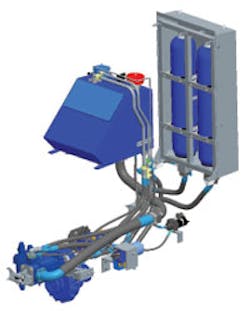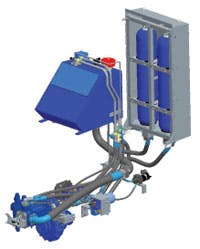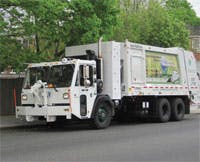Edited by Mary C. Gannon
For the first time, New York City’s Department of Sanitation (DSNY) will begin a nine to 12 month in-field evaluation of Bosch Rexroth’s Hydrostatic Regenerative Braking (HRB) system in a compressed natural gas (CNG) refuse truck — to assess its ability to add torque, increase functionality, reduce emissions, and boost fuel economy.
The project is being funded through National Grid’s Technology and Innovation program.
According to National Grid’s executive vice president for US Gas Distribution, Nick Stavropoulos, “This new hybrid offers the cleaner benefits of compressed natural gas while improving fuel efficiency and torque.”
The field evaluations are designed to authenticate the HRB system’s ability to add needed low-end torque to the trucks’ operation, replacing power lost by the use of CNG. DSNY will use this real-world operating data to consider larger-scale deployment of the technology within its in-service and new vehicle fleets. It will also prove HRB technology is fuel-neutral, in both CNG and diesel refuse trucks.
“The HRB system gives back some of the torque lost in the switch from diesel to CNG fuel, storing energy from the vehicles’ frequent braking and deceleration,” said Michelle DuHadway, manager of Parallel HRB accounts at Bosch Rexroth.
The trucks will be subjected to a variety of in-use testing, including braking, acceleration, route collection, and dynamometer testing to evaluate increased capability and fuel efficiency.
The HRB system is installed in a Crane Carrier Co. LET2 73,500 lb GVWR truck and will be integrated with a Heil Environmental 5000 25 yd3 rear-loader refuse body.
The Rexroth HRB system uses a hydraulic pump/motor in the drive train to capture kinetic energy during vehicle braking. When braking, the pump/motor acts as a pump, absorbing energy from the driveline and imparting a retarding force on the drive wheels, pumping hydraulic fluid into a nitrogen-pressurized accumulator. During acceleration, the pressurized gas pushes fluid out of the accumulator, and the pump/motor then acts as a hydraulic motor, adding power to the engine while reducing the fuel required to launch the vehicle.
Hybrid drivetrain technologies will become a “necessity” in the near future in the heavy truck market, said Glenn Pochocki, vice president of sales and marketing, refuse/chassis products, for Crane. “Bosch Rexroth’s hybrid HRB technology and system can be integrated into most medium- and heavy-duty truck vocations without impacting the vehicle’s configuration,” he said. “The HRB system on a CNG vehicle helps add critical power for operations while improving the vehicle’s fuel economy and extending brake system life.”
Visit www.boschrexroth-us.com for more information.
About the Author

Leaders relevant to this article:


